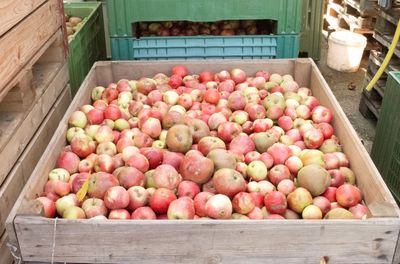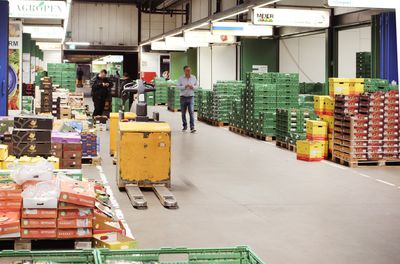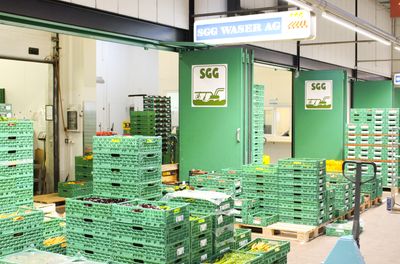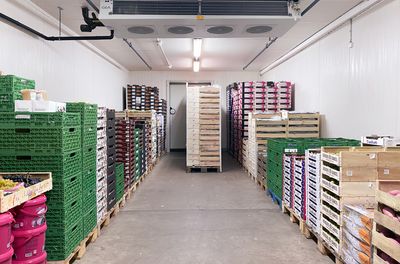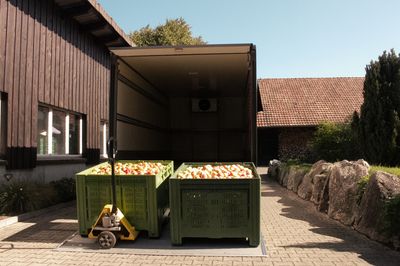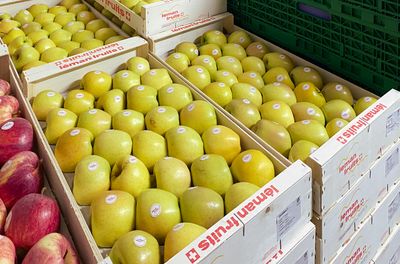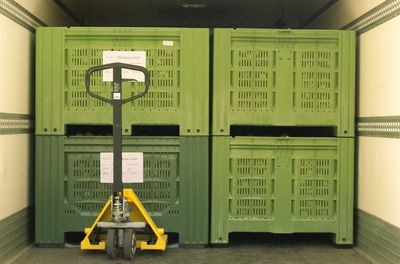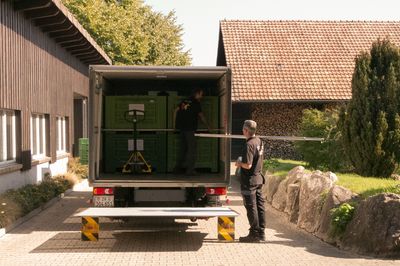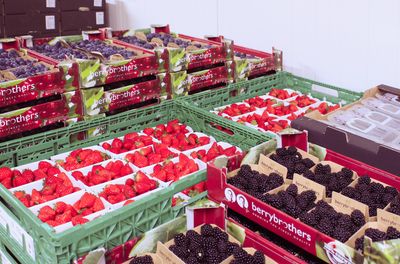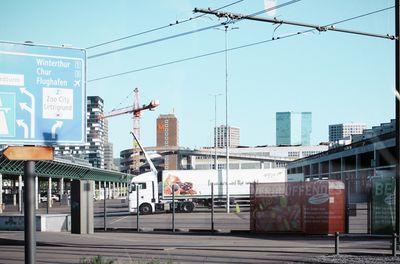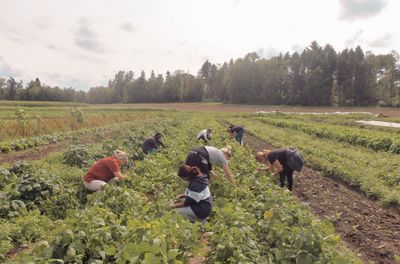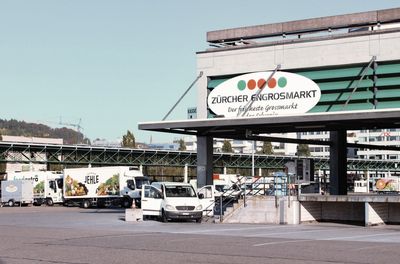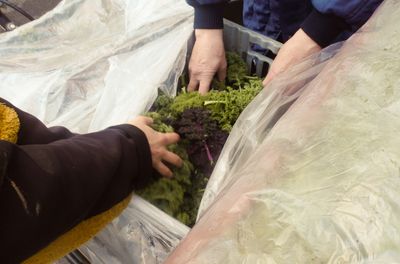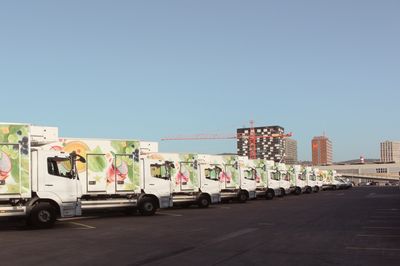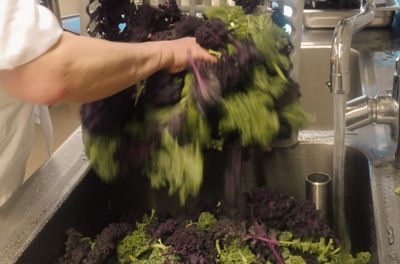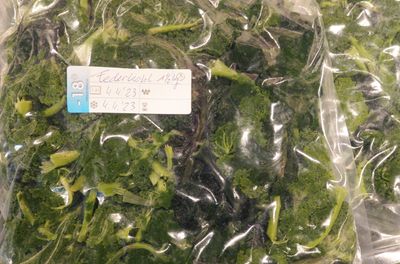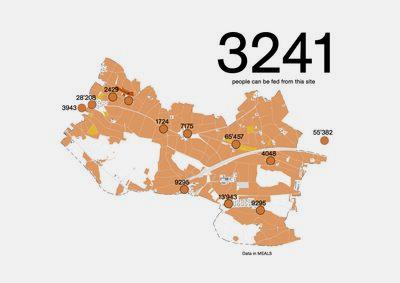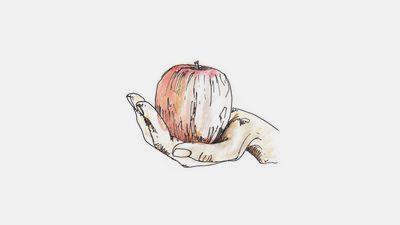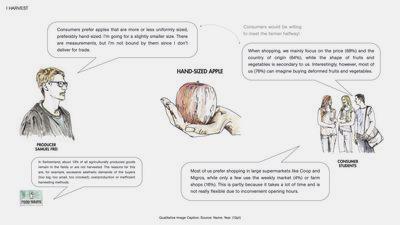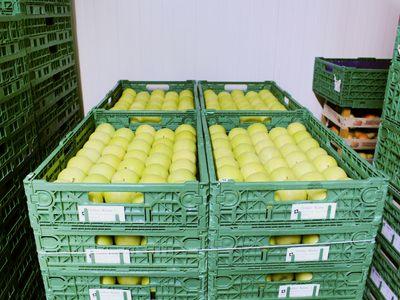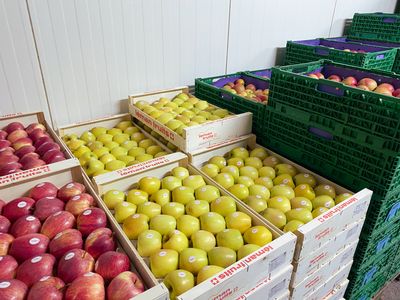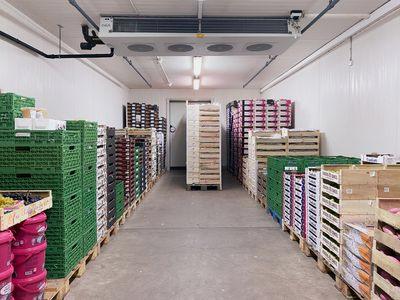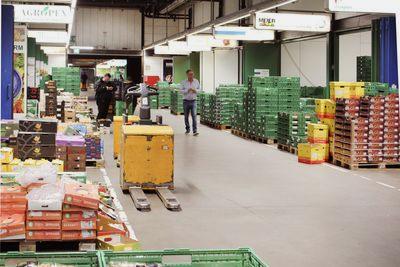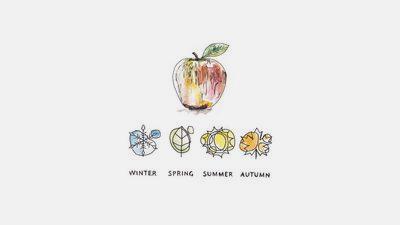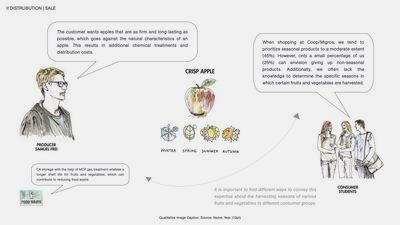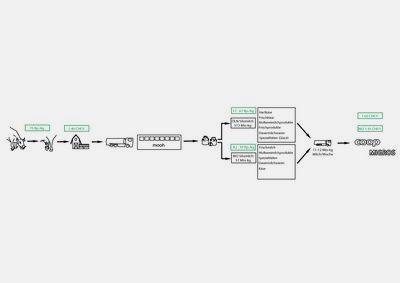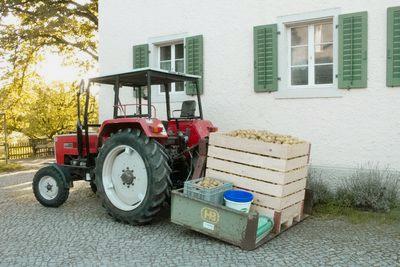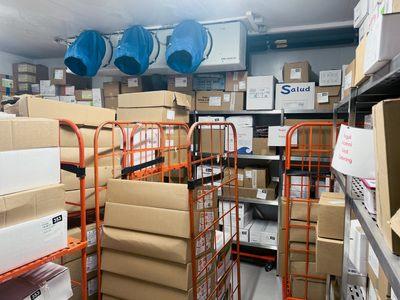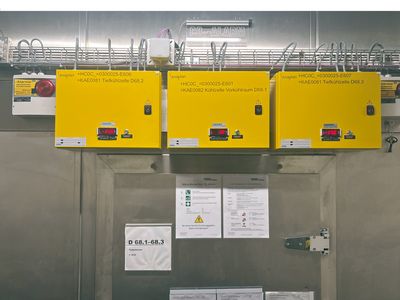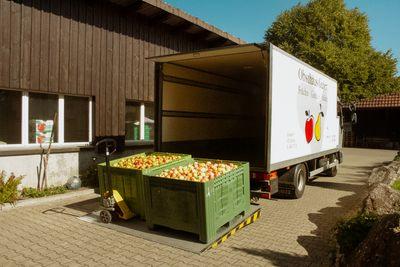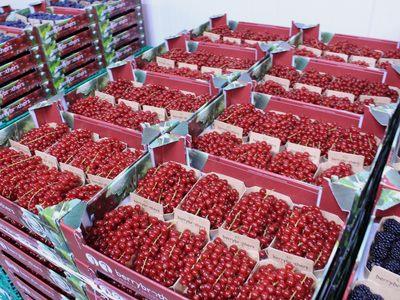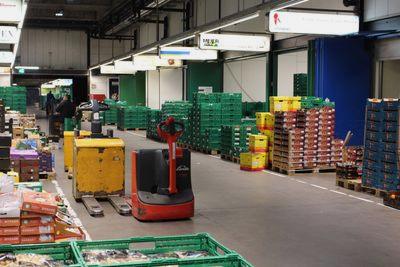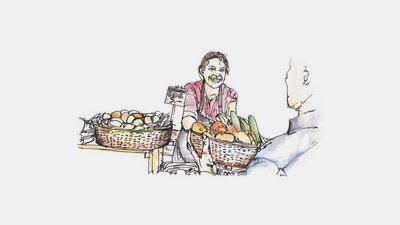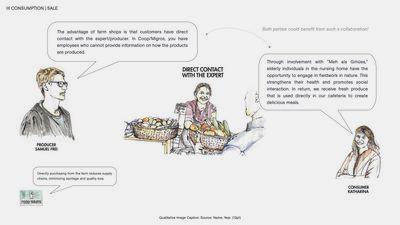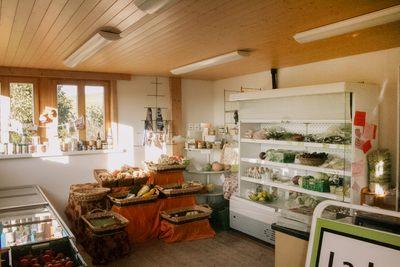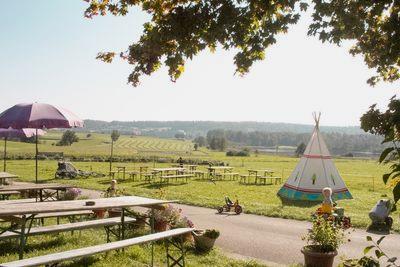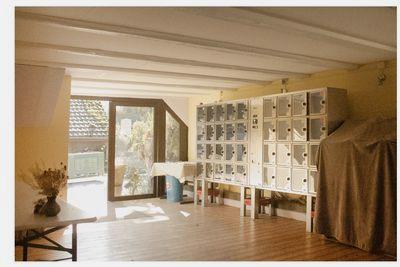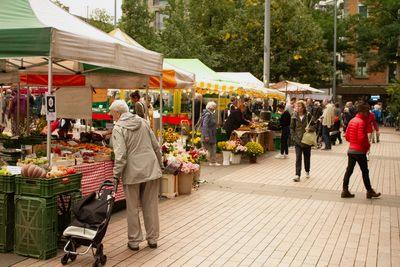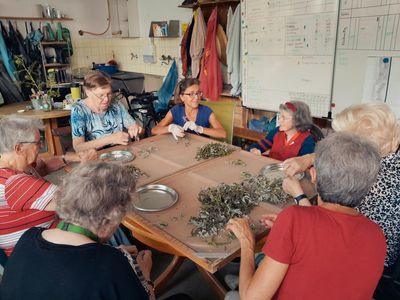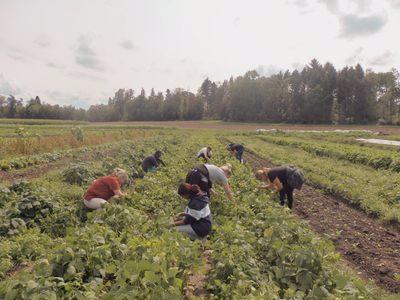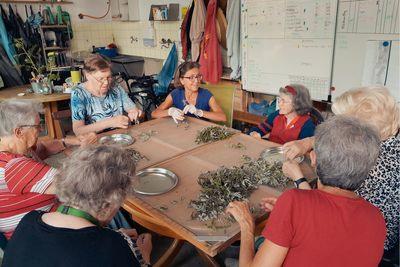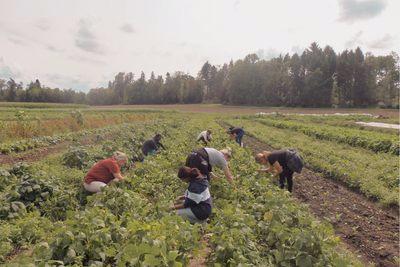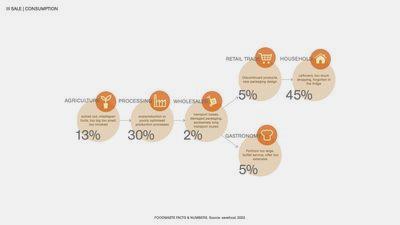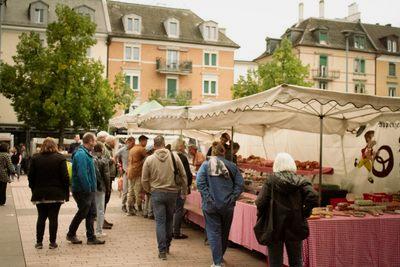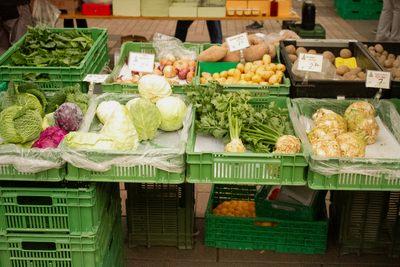AtlasFoodIrina Burau, Dilara Aydemir, Beda Sievi, and Raphael Ulli
The journey of food, from farm to table, involves a complex network of processes, transportation, and distribution. Understanding this web is essential to developing strategies that ensure the seamless flow of fresh, nutritious produce to the consumers of Zurich Nord.
Determining the number of individuals who can sustain themselves from the on-site food production involves a straightforward calculation. By multiplying the data on the quantity and caloric value of the produced items, we obtain the total calories generated on the site. With the average daily caloric requirement per person being 2,000 kcal, this implies that the food produced can adequately feed 3,241 people. However, 151 t of animal feed are produced on the site, which corresponds to 431,000,000 kcal. This could feed an additional 6,496 people. This raises the question of whether the region should reconsider its focus and prioritize food production for human consumption, or if the ongoing production of animal feed remains suitable for the future.
Out of the gathered on-site data, it is evident that 86 % of the 640.8 t of food production is directed for export rather than on-site consumption. The primary contributors to this export are 414 t of milk, followed by 151 t of apples. The remaining portion consists of a variety of fruits and vegetables as well as veal/beef and eggs.
Harvest
How do you know how much you produce?
Standardisation: Schweizerische Qualitätsbestimmungen Für Gemüse
Standards and quality. We all understand something different by quality. Its definition describes: “Quality is the condition of a unit with regard to its suitability to fulfill specified and presupposed requirements.” But these requirements must be specified somewhere in order to have certain reference points.
This is precisely what is clearly defined in the Schweizerische Qualitätsbestimmungen für Gemüse (quality standards for vegetables in Switzerland). These quality standards form the basis in the Swiss vegetable trade. In some cases, certain buyers also work with their own more advanced standards for size, minimum requirements or individual quality standards. The Schweizerische Qualitätsbestimmungen für Gemüse is thus not a state requirement, but rather an agreement between the trading partners. They apply to both conventional goods and organic products and so the idea that poorer quality is generally accepted in the organic segment is therefore not a correct statement.
Distribution
Why does one need chemical treatments?
Supply Chain Site Map
On our map, we have highlighted three contrasting distribution systems. Firstly, Frei’s Farm Shop primarily sells on-site or delivers directly to the nearby Volg shop upon request.
Secondly, we have the cooperative Meh als Gmües, which collaborates with the Wolfswinkel Health Center. In exchange for support during harvest, they deliver by bicycle directly to the healthcare center’s canteen.
The distribution process begins with the initial sorting of the harvest, where only a small portion (25-30 %) is discarded. After further sorting and washing, the produce is either sent directly to farm shops or farms in the region. Alternatively, the goods are transported to the MCP gas treatment facility. This treatment costs farmers 20-30 cents per kilogram. Afterwards, the produce either returns to farm shops or proceeds to the CA warehouse, ultimately reaching large retailers. The farmer incurs costs at each intermediate step but can sell these products at a fair price in their farm shop, whereas large companies undercut these prices significantly.
Supply Chain Network
The apple for the apple crumble cake at the family dinner has a long way to go before it reaches the plate.The supply chain starts at the very beginning in the field. The trees planted in spring grow. The apples grow. Beautiful round shiny apples, but among them also deformed and unattractive.The deformed and non-standard products are sorted out. The beautiful ripe ones are picked and brought to the local fruit facility. They are sorted, washed and treated, then packed and stored. From there they are further distributed to wholesalers like Coop and Migros or it goes back to the origin, back to the farm store. From the farm store they are sold partly to the surrounding farmers or partly on the market. The market, wholesaler or farm store is the final destination of an apple. This is where consumers come in. From these points they get their purchase for their home.
Milk also makes its way. From the cow, the milking it arrives in a later step at the dairy trader or as for example at the mooh cooperative. Some farmers sell their milk to the mooh cooperative, like the Waidhof, where it is processed, sold and also new dairy products are produced. The processed milk is then further transported, stored in warehouses and sold.
Controlled Atmosphere (CA) Storage
MCP gas treatment is a process where goods are fumigated for 24 hours, resulting in storage for three to six months. After MCP treatment, the products are stored in a CA (controlled atmosphere) warehouse with controlled temperature, humidity, and CO₂ supply. Here is an example of cucumber storage over a two-week period at different temperatures, which has a significant impact on yellowing.
The Network
The farm shops have established a complex system among themselves, strategically designed to cater to the diverse needs of each. The farms deliver their produce to other farms on the site which leads to a broader selection of products and thus a more convenient buying experience for the customers. The farmers deliver the products on demand by wheelbarrows, bicycles and small cars. This short and efficient supply chain eliminates the necessity for a cold chain, maintaining the freshness of the products throughout the transportation process
Sale and Consumption
What are the benefits of your Farm Store?
Hofläden: Three Typologies
Across the site there are three distinct typologies on how to buy the locally produced products. The first comprises traditional farm shops characterized by specific opening hours and direct interaction between customers and producers. The second typology involves a restaurant that provides a space for socializing. The third typology is represented by a 24/7 automatic farm shop.
Price Comparison of Food Produce
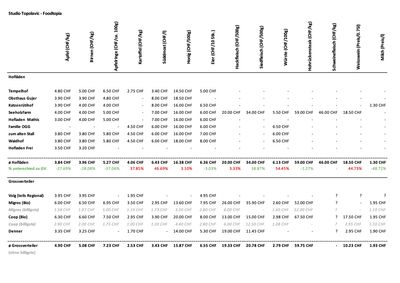
Are regional products from the farm shop really always more expensive? We wanted to get to the bottom of this question and compared the prices of the most common products of all farm shops in the perimeter with the corresponding organic products from the wholesaler.
We found that not all products are more expensive in the farm shop than in the wholesaler. However, the farm shops do not stand a chance against the cheap brands of M-Budget and Prix Garantie. On the other hand, products such as apples, pears or eggs that are not produced locally in unlimited quantities are up to 40 % cheaper in the farm shop than in the wholesale trade. This can be explained on the one hand by the huge margins of Coop & Migros, and on the other hand by the shortened supply chain and the corresponding costs that are thus eliminated. Products such as meat or potatoes are significantly more expensive. Higher prices are the result of higher production costs and the small farms. Due to economies of scale, large specialised farms can offer these products at prices that the local farmer cannot compete with.
The statement that products are always more expensive at the farmers’ cannot be confirmed by our price comparison. Surprisingly, many goods are even cheaper in the farm shop, as the products have a much shorter journey behind them and have fewer intermediate hangs.
Series of Social Events in the Field of Agriculture
Markets and farms, as vibrant hubs of culinary activity, play a crucial role in enhancing the social experience associated with food. Farmers’ markets, with their colorful array of fresh produce and local delicacies, create a lively and bustling atmosphere that draws people together. These spaces become more than just transactional sites; they evolve into communal areas where individuals gather to explore, taste, and connect with both the food and each other.
Foodwaste
Food waste already starts in the field. 13 % are not harvested or are sorted out because they do not meet the high quality standards of the Swiss market. The consumption behaviour of Zurich residents has a direct impact on the agricultural output in Zurich North. To foster meaningful change, consumers need to rethink their diets and buying habits.The standardisation imposed on vegetables and fruits often results in significant food waste or forces farmers to find alternative uses, such as transforming misshapen apples into cider. Unfortunately, many of these imperfect products are still getting disposed off. Intriguingly, our survey data reveals that 76 % of individuals would be open to purchasing deformed vegetables and fruits. This prompts the question: why persist in current practices when consumer preferences lean towards embracing a more inclusive approach to agricultural produce?
In 2021, the city of Zurich initiated a pilot project mandating the utilisation of non-standardized vegetables and fruits in its 450 catering establishments. Challenges faced by the project included the absence of a supply chain and logistical solutions. To address this, collaboration was established with local initiatives, Good Market and Ackr, specialising in the promotion of non-standard vegetables. Since September 2023, all canteens have had access to non-standardised vegetables.
The Future
Addressing the lack of spaces for consuming locally produced food and reconnecting people with the source of their sustenance requires a multi-faceted approach that involves education, infrastructure development, and community engagement.
Firstly, there is a need for educational initiatives to inform the public about the benefits of consuming locally produced and seasonal foods. Workshops, cooking classes, and informational campaigns can teach people not only about the nutritional advantages but also about the positive environmental and economic impacts of supporting local agriculture. Encouraging an understanding of seasonal eating fosters an appreciation for the natural cycles of food production.
Infrastructure development is crucial to providing spaces for people to consume locally produced food on-site. This may involve the creation of community spaces, food courts, or designated areas within farmers’ markets where people can enjoy meals prepared with fresh, local ingredients. Collaborations between local governments, businesses, and community organisations can help fund and implement these projects.
In the long term, community engagement is key to the success of these initiatives. Building a sense of pride and ownership in locally produced food can involve community events, festivals, and ongoing educational programs. By fostering a strong community connection to the food system, people are more likely to support and actively participate in the shift towards a more sustainable and locally focused approach to food consumption.

Site Map.
- Farmshops
- Purchaser regional products
 agricultural land
agricultural land agricultural land for fruits and vegetables
agricultural land for fruits and vegetables vineyards
vineyards- public transport
- important streets for food supply
- bike trails
- walking trails
- Farm Samuel Frei: movement of the produced food
- Farm Gujer: movement of the produced food
- Farm Meh als Gmües: movement of the produced food

